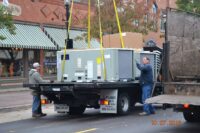As a significant portion of energy consumption in both residential and commercial settings, HVAC systems offer plenty of opportunities for efficient improvements. HVAC and plumbing provide crucial comfort and sanitary systems for each building, but the systems are not always installed, implemented, or used efficiently. Ineffective use of these systems can lead to lost energy Read more
Smart Data Systems

As a significant portion of energy consumption in both residential and commercial settings, HVAC systems offer plenty of opportunities for efficient improvements. HVAC and plumbing provide crucial comfort and sanitary systems for each building, but the systems are not always installed, implemented, or used efficiently. Ineffective use of these systems can lead to lost energy, an excessively high comfort threshold, or greater stress on the equipment. By considering these factors, HVAC professionals can target their efforts to greater efficiency and optimal system performance.

Ensure Optimal Installation
Optimal installation can improve output, decrease the likelihood of overuse or system failure, and maintain a higher level of efficiency. Proper sizing is key. HVAC specialists should perform thorough load calculations and estimate the needs for temperature and humidity control in the space to determine the correct output range for the equipment. Installing temperature sensors in places without sun exposure or drafts can help to ensure accurate temperature control. Comprehensive testing of the equipment post-installation can confirm that the system works properly with correct output and high efficiency.
Optimize Damper Position
Damper position controls the volume of air that can enter a space at any given time. Variable air volume (VAV) boxes adjust the temperature and rate of airflow based on the load. In many cases, a VAV box’s damper position sits open to a higher degree than necessary, leading to wasted energy and improper temperature control. Setting the damper position to the minimum according to ASHRAE standards can minimize energy consumption without compromising performance.
Utilize Smart Data Systems
Smart systems can predict usage needs based on existing data about operation in similar spaces and can also adjust schedules and other controls for the needs of a particular space. Systems collect data about routine usage and use that information to create efficient settings for HVAC and plumbing. Sensors track temperature in individual rooms, providing real-time data about system efficacy and allowing owners to tailor usage for maximum comfort and efficiency. Use of these systems can decrease the number of manual overrides, as well as maintaining a precise level of temperature and humidity control.
Implement Temperature Controls
Dynamic temperature controls can minimize the use of energy to heat supply air or water, reducing energy consumption without compromising the ability to meet demand. Supply air controls can dictate the temperature of the supply air, adjusting upward or downward depending on the load. Similarly, boiler and water heater temperature controls can adjust the minimum or maximum temperature of the operating limit based on demand. Systems that change these limits dynamically can provide better heating for high demand, while minimizing use during lower load times.
Decrease Unnecessary Operations
A system that works automatically can provide heating, cooling, and ventilation when none is needed, calling for attention to unnecessary operation. Inaccurate scheduling, excessive manual overrides, and a lack of zoning systems can contribute to wasted energy. Specifically, owners should create commercial HVAC settings that maintain the proper temperature and humidity for the right times, minimizing use outside of peak hours. Adjusting ventilation based on occupancy can help to maintain a comfortable indoor temperature for areas with fewer numbers, while maintaining ideal ventilation in crowded spaces. Implementing smart automated systems can make the transition effortless, allowing building owners to manage dynamic heating, cooling, and plumbing needs.
Designing an HVAC or plumbing system to meet the needs of a space requires some analysis of overall efficiency. Overuse or ineffective use of a system can make a space feel uncomfortable or unsanitary, while contributing to high energy usage or increased repair needs. Evaluating the installation, setup, and use of each system can highlight ways for HVAC professionals to improve efficiency and performance. By adding smart technology and following best practices in mechanical systems, HVAC technicians and plumbers can eliminate wasted energy and accurately reach the comfort goals for the space.
Author Bio: Michael Carlson is the President of Gene May Heating & Cooling. He has been in the heating and cooling industry for more than 32 years and is the sole owner of the business.
